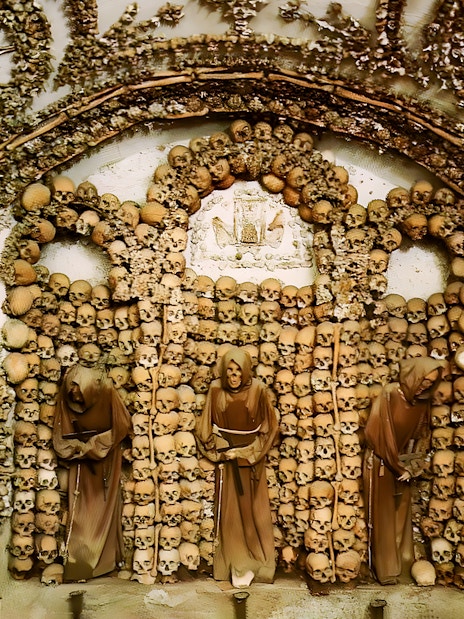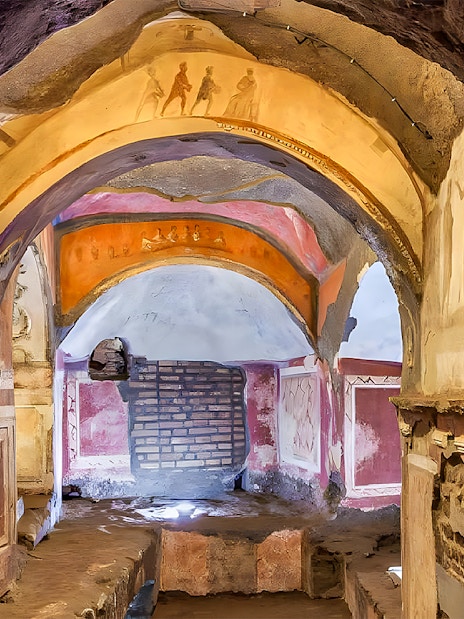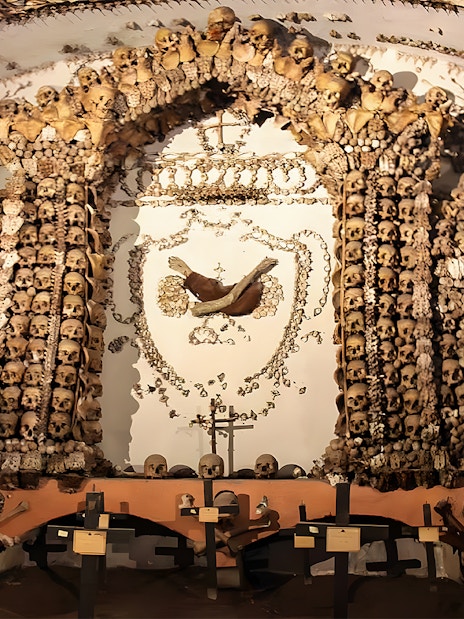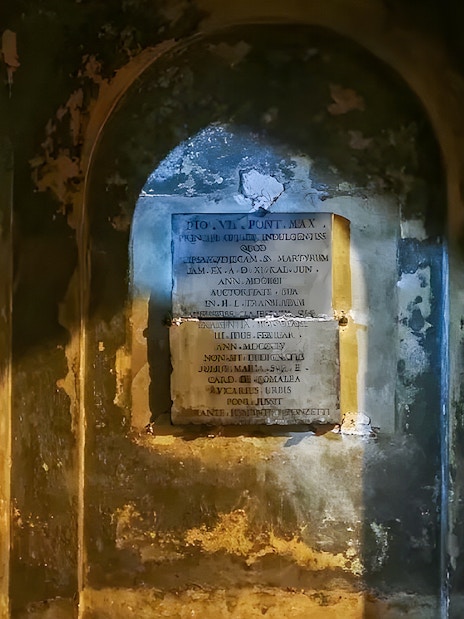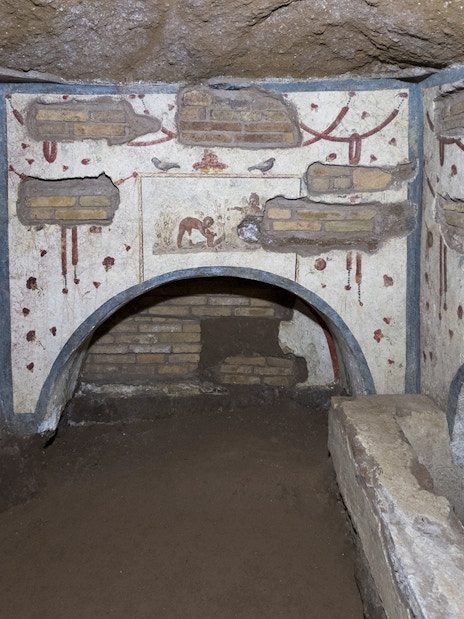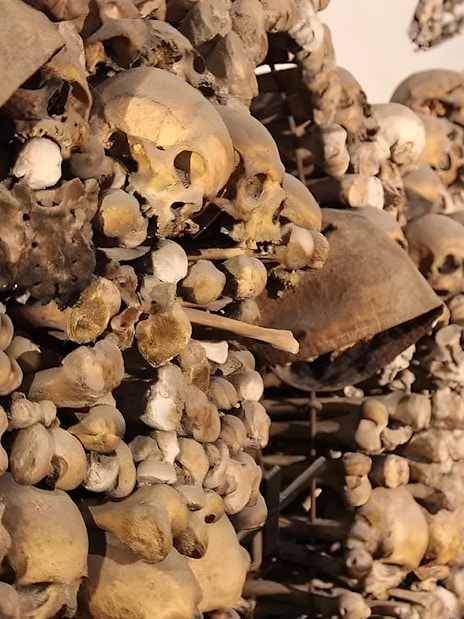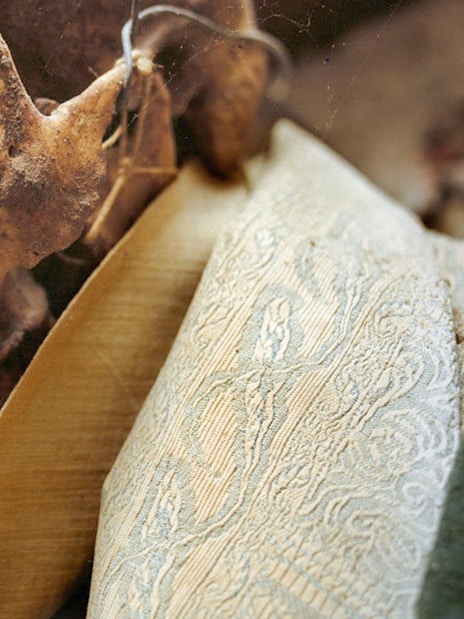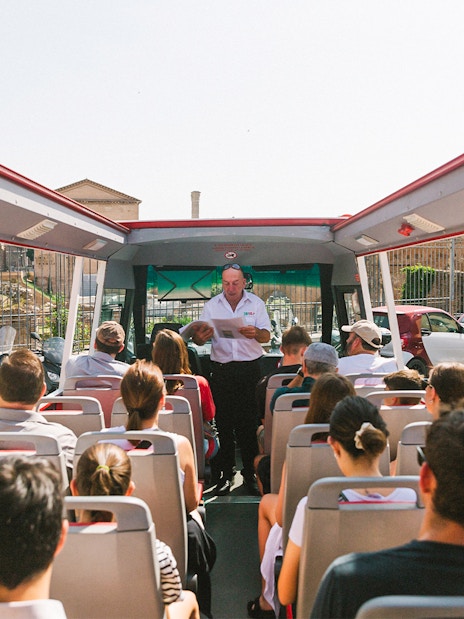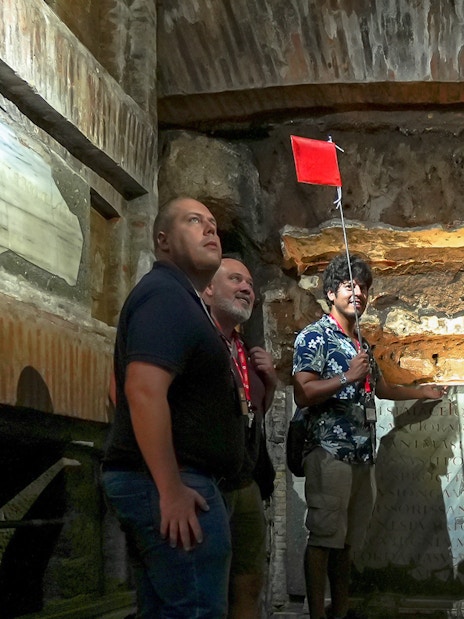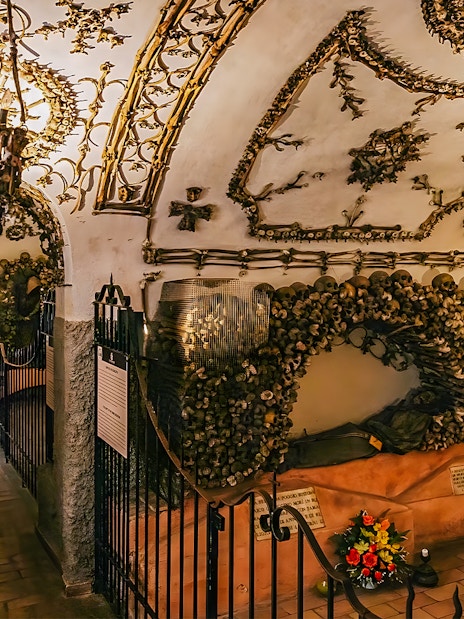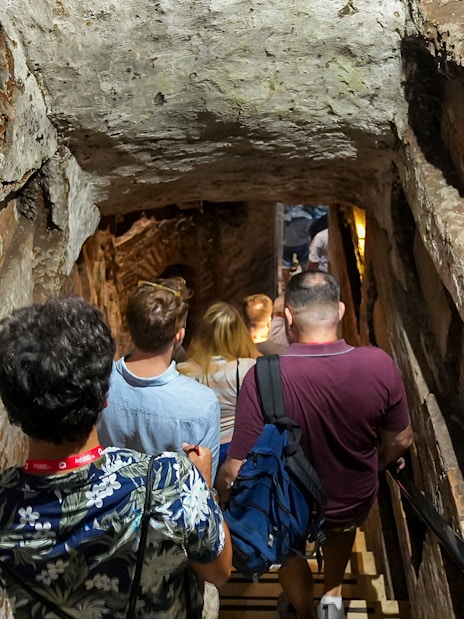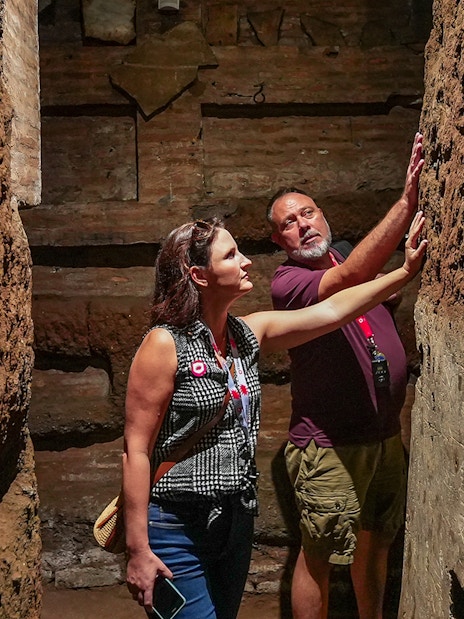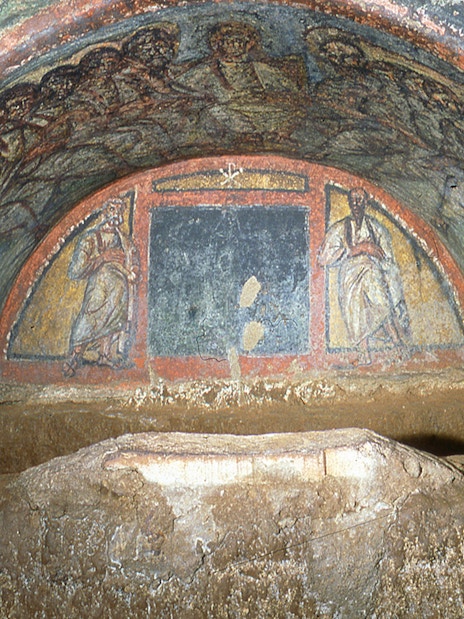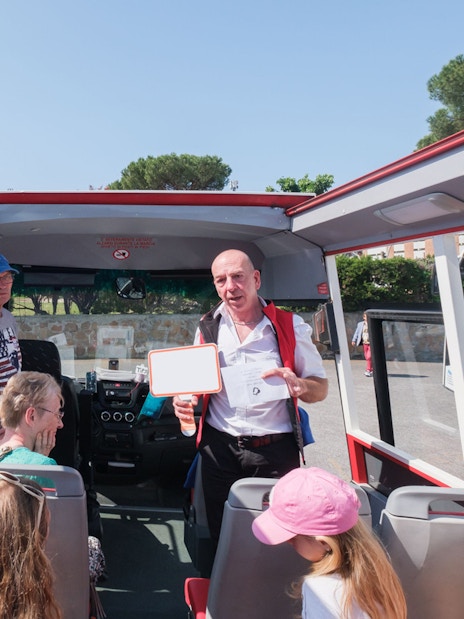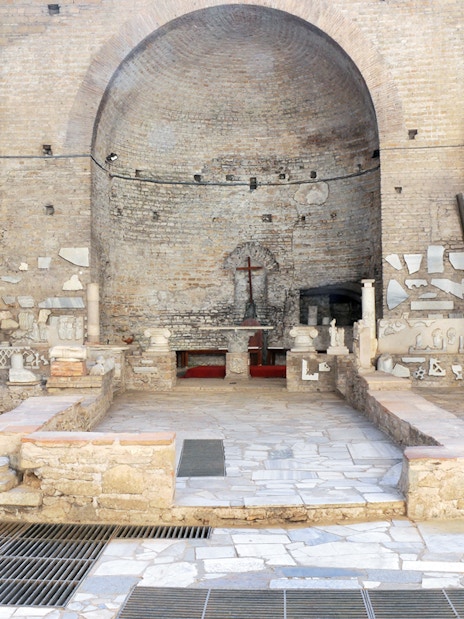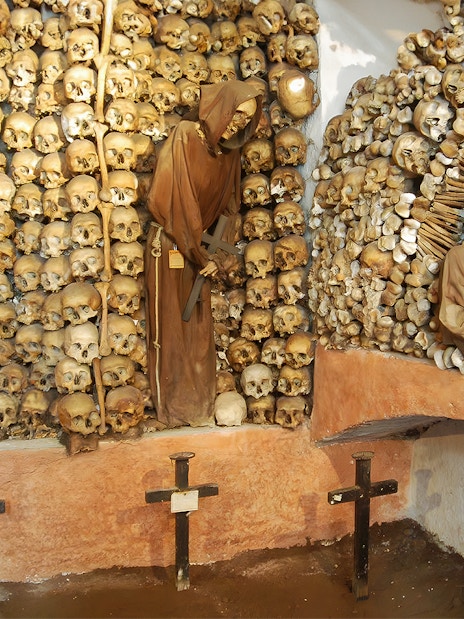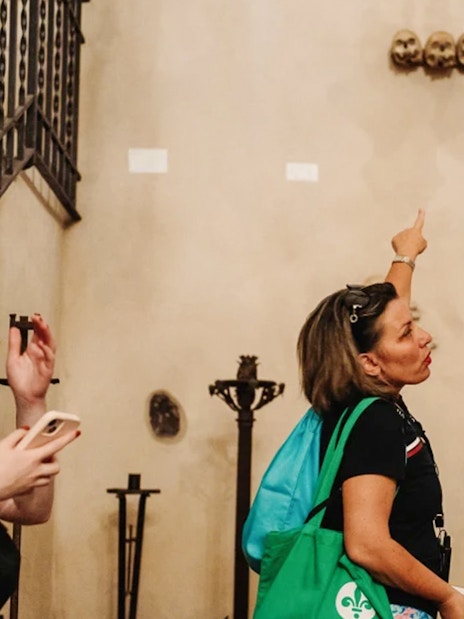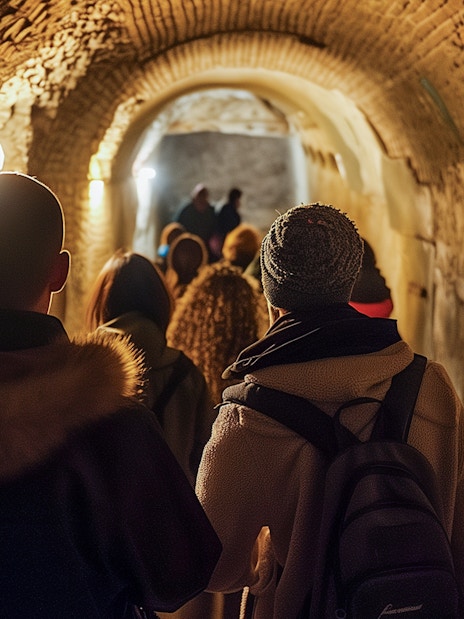- Roman Catacombs
- Catacombs of Saint Sebastian
- San Nicola
- Catacombs of Domitilla
- Catacombs of Callixtus
- Capuchin Crypt
- Catacombs of Saint Agnes
- Catacombs of Commodilla
- Catacombs of Priscilla
- History
- Appian Way
- Christian Catacombs
- Jewish Catacombs
Capuchin Crypt Tours

See the remains of 4,000 friars with fast-track entry and audio guide, or upgrade for transfers and guided catacombs tour.
- Skip the wait at long ticketing lines and walk straight into the chilling Capuchin Crypt at your chosen time slot.
- See the infamous bone-chilling artwork made of skulls and skeletons while learning about its history and symbolism with your audio guide.
- Level up your adventure with a combo guided tour of the Catacombs—Domitilla (except Tuesdays) or St. Callixtus (Tuesdays only)—with convenient one-way open-bus transfers to each site.
- Go all-in with a full package that includes the Catacombs, Capuchin Crypt, and San Nicola Basilica—plus round-trip AC coach transfers to and from central Rome for a seamless experience.
See the remains of 4,000 friars with fast-track entry and audio guide, or upgrade for transfers and guided catacombs tour.
- Skip the wait at long ticketing lines and walk straight into the chilling Capuchin Crypt at your chosen time slot.
- See the infamous bone-chilling artwork made of skulls and skeletons while learning about its history and symbolism with your audio guide.
- Level up your adventure with a combo guided tour of the Catacombs—Domitilla (except Tuesdays) or St. Callixtus (Tuesdays only)—with convenient one-way open-bus transfers to each site.
- Go all-in with a full package that includes the Catacombs, Capuchin Crypt, and San Nicola Basilica—plus round-trip AC coach transfers to and from central Rome for a seamless experience.
Inclusions
- Entry tickets to Museum & Crypt of the Capuchin Friars
- Audio guide
- Guided tour of the Domitilla Catacombs (except on Tuesdays) or St. Callixtus Catacombs (Tuesdays only) with one-way transfers (as per option selected)
- Guided tour of Christian Catacombs and Basilica of San Nicola with round-trip transfers(as per option selected)
- Arrive atleast 15 minutes prior to your picked slot.
- Minors are advised to enter the crypt only when accompanied by an adult.
- Children up to 6, visitors with disabilities (plus one companion), Capuchin friars, and national tourist guides enter for free.
- Note that tours are not wheelchair accessible.
- Photography and videography are prohibited inside the Catacombs.
- These tickets can't be cancelled or rescheduled.
Itinerary
START POINT
Piazza Barberini
Meet your expert historian guide at Piazza Barberini, beside the fountain of Triton. In a morbid tradition, this square once served as a place where unidentified bodies were displayed for public recognition until the 1800s.
0.23 km
1 minute
1
Museum & Crypt of the Capuchin Friars
Tickets included
Tune into an audio guide as you explore the Museum and Crypt of the Capuchin Friars, where underground chapels are adorned with intricate skeletal art, blending the macabre with spiritual reflections.
6.8 km
22 minutes
2
Appian Way Catacombs
Tickets included
Venture into subterranean galleries at either one of the catacombs – St. Callixtus, Domitilla, or St. Sebastian. The site visited depends on the date selected and how crowded it is at the time of your tour. Whichever one you experience will offer a profound journey into early Christian history.
6.9 km
17 minutes
3
San Nicola in Carcere
Tickets included
This medieval church was built over the ancient Forum Olitorium, once home to three temples during the Roman Republic. In the Middle Ages, these temples were repurposed into a prison, giving the church its evocative name, "in Carcere" (in prison). Enjoy an intriguing guided exploration.
4 km
16 minutes
4
END POINT
Piazza Barberini
Explore three unique underground sites—Bone Chapel, Domitilla/Callixtus Catacombs & an ancient basilica—connected via round-trip transfers.
- Save time and effort with round-trip transfers from central Rome, ensuring a smooth journey between these historic sites spread across the city.
- Explore the Museum and Crypt of the Capuchin Friars with an audio guide, where the remains of 4,000 Capuchin priests adorn the underground chapels.
- Time-travel underground with a guided tour of one of the catacombs along the Appian Way—Domitilla, St. Callixtus, or St. Sebastian—depending on the day of your visit.
- Descend into the Basilica of San Martino ai Monti, a minor yet stunning basilica tucked away near the Colosseum. It's one of the city's oldest churches, dating back to the 4th century.
- Looking for an alternative? Swap San Nicola Basilica for a visit to the legendary Bocca della Verità (Mouth of Truth), Santa Maria in Cosmedin & Hadrian’s Crypt.
Explore three unique underground sites—Bone Chapel, Domitilla/Callixtus Catacombs & an ancient basilica—connected via round-trip transfers.
- Save time and effort with round-trip transfers from central Rome, ensuring a smooth journey between these historic sites spread across the city.
- Explore the Museum and Crypt of the Capuchin Friars with an audio guide, where the remains of 4,000 Capuchin priests adorn the underground chapels.
- Time-travel underground with a guided tour of one of the catacombs along the Appian Way—Domitilla, St. Callixtus, or St. Sebastian—depending on the day of your visit.
- Descend into the Basilica of San Martino ai Monti, a minor yet stunning basilica tucked away near the Colosseum. It's one of the city's oldest churches, dating back to the 4th century.
- Looking for an alternative? Swap San Nicola Basilica for a visit to the legendary Bocca della Verità (Mouth of Truth), Santa Maria in Cosmedin & Hadrian’s Crypt.
Inclusions
- Expert English-speaking guide
- Groups of up to 25 guests
- Round-trip AC coach transfers from central Rome
- Entry to the Museum & Crypt of the Capuchin Friars with audio guide
- Guided tour of St. Callixtus/Domitilla/St. Sebastian Catacombs with skip-the-line entry
- Guided tour of Capuchin Crypt (as per option selected)
- Entry to San Martino ai Monti (as per option selected)
- Visit to Santa Maria in Cosmedin & Pope Hadrian’s Crypt, Bocca della Verità (Mouth of Truth) (as per option selected)
Exclusions
- Hotel pick up and drop off
- Food & beverages
- You can cancel these tickets up to 24 hours before the experience begins and get a full refund.
Itinerary
START POINT
Piazza d'Aracoeli
Begin your guided tour from this central location in Rome, and end it at the Capuchin Crypt.
6 km
18 minutes
1
Catacombs of Domitilla
40 min
Tickets included
Home to some of the grandest cubicula around, these catacombs boast an intricate network of tunnels and a 2nd-century semi-undergound Basilica dedicated to Saints Nereus and Achilleus.
6.8 km
22 minutes
2
Museum & Crypt of the Capuchin Friars
Tickets included
This part of the tour is unguided – turn up your audio guide and independently explore the hauntingly beautiful chapels decorated by skeletal art, blending the macabre with the spiritual.
3
Crypts & Catacombs: Art made of Bone, dark stories of burial chambers, and no travel stress.
- Travel hassle-free with pre-arranged transfers, skipping the stress of navigating these offbeat, spread-out sites on your own.
- Explore the ancient Catacombs of Domitilla or St. Callixtus (on Tuesday) with a guide, see frescoed tombs, underground basilicas, and the resting places of early Christians.
- Visit the eerie Capuchin Crypt, where bones of 4,000 friars form intricate memento mori artwork, and learn about its history with an audio guide.
Crypts & Catacombs: Art made of Bone, dark stories of burial chambers, and no travel stress.
- Travel hassle-free with pre-arranged transfers, skipping the stress of navigating these offbeat, spread-out sites on your own.
- Explore the ancient Catacombs of Domitilla or St. Callixtus (on Tuesday) with a guide, see frescoed tombs, underground basilicas, and the resting places of early Christians.
- Visit the eerie Capuchin Crypt, where bones of 4,000 friars form intricate memento mori artwork, and learn about its history with an audio guide.
Inclusions
- Half-day tour around Domitilla Catacombs and Capuchin Crypt
- Guided tour of Domitilla Catacombs with entry (except Tuesday)
- Guided tour of St. Callixtus Catacombs with entry (only Tuesday)
- Expert English, Italian, German, French, or Spanish-speaking guide
- One-way transfers
- Entry to the Museum & Crypt of the Capuchin Friars with audio guide
Exclusions
- Guided tour of the Museum & Crypt of the Capuchin Friars
- Return transfers to Rome
- Hotel pick-up and drop-off
- Food & beverages
- Arrive at least 15 minutes prior to your picked slot, as latecomers would not be accommodated.
- This experience is not wheelchair accessible, and not recommended for those with claustrophobia or serious mobility issues.
- Strict dress code: Clothing that covers the knees and shoulders.
- Photography and videography is prohibited inside the catacombs.
- You can cancel these tickets up to 24 hours before the experience begins and get a full refund.
Make the most of Rome
Your Capuchin Crypt tour options explained
Features
Guided tours
Tours with transfers
Guide
✅
🎧
Transfers
❌
🚌
Additional stops
St. Callixtus/Domitilla/St. Sebastian Catacombs (based on availability), San Nicola Basilica
Domitilla Catacombs, St. Callixtus Catacombs
Capuchin Crypt | Quick facts

- Historical significance: Final resting place for 4,000 Capuchin monks, created to embody the "memento mori" philosophy.
- Time period: Built in the 17th century, with burials from 1500 to 1870.
- Current use: A tourist site and reflection spot featuring artistic bone displays, alongside a museum on Capuchin life.
- Accessibility: Located under Santa Maria della Concezione, Via Vittorio Veneto, Rome. Open daily: 10am - 7pm.
- Key features: Five chambers decorated with bones and skulls in intricate designs. Crypt of Skulls, Crypt of Leg Bones, and the Mass Chapel (relics but no bones). Unique displays like chandeliers from shoulder blades, clocks from vertebrae.
What are Capuchin Crypt opening hours?

Daily:
Morning: From 9:30am to 1:30pm (last entry at 12:30pm)
Afternoon: From 2:30pm to 6:30pm (last entry at 5:30pm)
Days closed:The Capuchin Crypt is closed on December 25, January 1, and Easter Sunday.
Complete schedule of Roman CatacombsWhere is Capuchin Crypt located?
Address: Via Vittorio Veneto, 27, 00187 Roma RM, Italy.
The Capuchin Crypt is located beneath the Church of Santa Maria della Concezione dei Cappuccini, which is just a few steps away from the famous Palazzo Barberini.
- By bus: Take bus routes 52, 63, or 175 to the nearest stops, which are a short walk from the crypt.
- By metro: The closest metro station is Barberini on Line A. From there, it’s just a few minutes' walk to the Capuchin Crypt.
Highlights of Capuchin Crypt

Crypt of the Three Skeletons
This crypt features three skeletons enclosed in an oval, symbolizing the cycle of life and death. One skeleton holds a scythe representing mortality, while the other holds scales symbolizing judgment of one's deeds. A placard reminds visitors of the universal truth: "What you are now we used to be; what we are now you will be..."

Crypt of the Resurrection
Here, you will find a powerful display of human bones arranged to frame a picture of Jesus raising Lazarus from the dead. It serves as a visual representation of the theme of resurrection and the triumph over death.

The Chapel for the Mass
This is a non-bone area where mass is celebrated. It houses an altarpiece depicting Jesus, Mary, and saints urging the release of souls from Purgatory. The chapel also contains the heart of Maria Felice Peretti, the grand niece of Pope Sixtus V, and the tomb of Papal Zouaves who died defending the Papal States.

Crypt of the Skulls
The crypt showcases an arrangement of human skulls, creating a macabre yet fascinating sight that reflects the transience of life and the inevitability of death.

Crypt of the Basins
It features the arrangement of human pelvis bones, forming basins. This unique display highlights the physicality of the human body and creates a thought-provoking and visually striking experience for visitors.

Crypt of the Tibias and Femurs
The crypt displays a collection of leg bones and thigh bones, highlighting the structure and strength of the human lower extremities in an artistic and thought-provoking manner.
Frequently asked questions about the Capuchin Crypt tickets
Yes, all Capuchin Crypt tickets include entry to the Museum of the Capuchin Friars, where you can explore exhibits on the history of the order, their lifestyle, and the fascinating connection between art and faith.
Yes, you can explore the crypt and museum independently with the help of an audio guide included in your ticket. However, guided tours offer more in-depth insights into the crypt’s history and its symbolic bone decorations.
The bones are meticulously arranged along the walls of the crypt, forming intricate and elaborate designs. They are integrated into decorative motifs, including chandeliers, arches, and even a clock made of bones.
The crypt was initially created as a burial site for the Capuchin friars. It served as a powerful reminder of the transient nature of life and the inevitability of death.
Yes, some guided tours help you skip lines, which is particularly helpful during peak seasons like spring and summer when queues can get long.
Yes, children can visit the crypt, but keep in mind that the bone displays might be unsettling for young visitors. Consider preparing them beforehand or opting for a museum-only visit if needed.
Most visits to the Capuchin Crypt, including the museum, take about 45 minutes to an hour. Guided tours might take slightly longer, depending on the itinerary.
Unfortunately, the crypt and its underground chambers are not wheelchair accessible due to its historic structure and narrow staircases.
While there are no restrooms or cafés directly within the crypt, you’ll find facilities and dining options around Piazza Barberini, a short walk away.

